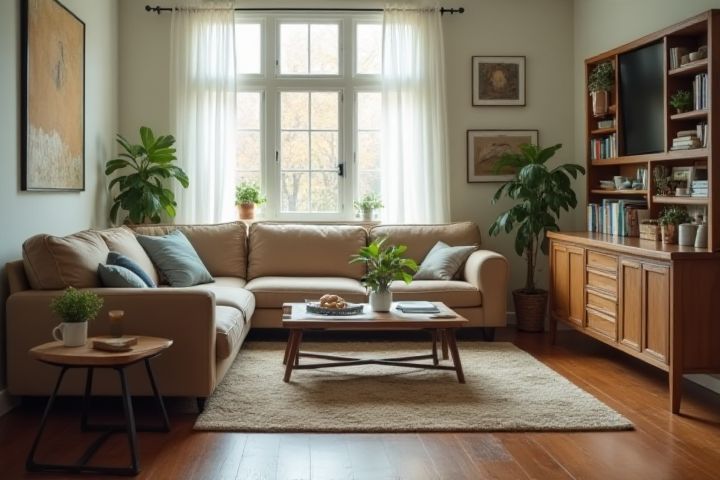
To minimize house clutter, start by prioritizing organization in each room. Utilize storage solutions like bins, shelves, and drawers to keep items neatly tucked away. Regularly assess your belongings and apply the "one-in, one-out" rule; for every new item you bring in, consider donating or discarding an existing one. Designate a specific place for everything, ensuring that daily-used items are easily accessible while less frequently used items are stored away. Establish a routine for decluttering, dedicating time each week to reassess and reorganize spaces to maintain a tidy home.
How To Minimize House Clutter
Opt for multi-functional furniture
Opting for multi-functional furniture is a highly effective strategy to minimize house clutter. Pieces such as ottomans that open for storage or coffee tables that convert into workspaces can dramatically enhance your living area's versatility. By selecting furniture that serves multiple purposes, you can reduce the number of items in your home, freeing up space and creating a more organized environment. Consider measuring your space carefully to choose the best multi-functional options that fit your needs and style, optimizing both aesthetics and functionality.
Implement a one-in-one-out rule
Implementing a one-in-one-out rule is an effective strategy to minimize house clutter. This approach mandates that for every new item you bring into your home, you must remove an existing item. This not only helps in maintaining a balanced inventory of possessions but also encourages mindfulness about your purchases. By consistently applying this rule, you can create a more organized living space while fostering a habit of thoughtful acquisition.
Embrace vertical storage
Embracing vertical storage can significantly minimize house clutter by maximizing your available space. Consider installing shelves, wall-mounted organizers, or hooks to utilize vertical surfaces, allowing you to keep frequently used items easily accessible while freeing up floor space. Optimize closet space with stackable bins and hanging organizers that make use of vertical height, ensuring everything has its designated spot. By incorporating furniture with built-in storage, such as ottomans or beds with drawers, you can further streamline your living area and create a more organized environment.
Regularly declutter and donate
Regularly decluttering your home can significantly minimize house clutter and improve overall organization. Set a schedule, such as once a month, to go through each room and assess your belongings, focusing on items you haven't used in over six months. Consider donating items in good condition to local charities or organizations, which can help others while freeing up space in your home. By making this routine a habit, you can maintain a more streamlined and peaceful living environment.
Use clear storage containers
Using clear storage containers allows you to easily identify contents at a glance, making organization more efficient. These transparent bins not only maximize visual accessibility but also contribute to a tidy aesthetic in your home. Labeling each container with specific categories, such as seasonal clothing or kitchen gadgets, enhances practicality and promotes consistent organization. When you can see what you have, it's simpler to minimize clutter and maintain a clean living environment.
Create designated "drop zones
Establishing designated "drop zones" in your house can significantly minimize clutter and enhance organization. Consider allocating specific areas near entrances or high-traffic spots for items like keys, bags, and mail, which can often accumulate. You can utilize baskets, bins, or hooks in these zones to keep items contained and easily accessible, promoting a habit of putting things where they belong immediately. By implementing this strategy, you can maintain a more orderly living space, with the potential to reduce daily clutter by up to 50%.
Adopt a minimalist mindset
Adopting a minimalist mindset can significantly reduce house clutter by encouraging you to prioritize essential items. Start by assessing your belongings and identifying what truly adds value to your life; aim to declutter by removing at least 10% of items each month. Create a designated space for everything, ensuring that each item has a purpose, which can save you time and improve overall organization. Fostering a routine of regular decluttering--perhaps monthly or seasonally--reinforces a minimalist approach, keeping your living space serene and functional.
Store items based on frequency of use
To minimize house clutter, prioritize storing items based on their frequency of use. Frequently used items should be easily accessible, placed in prime locations such as kitchen counters or shelves within arm's reach. Seasonal or seldom-used items can be stored in less accessible areas, like attics or deep storage bins. Organizing your belongings this way not only enhances functionality but also creates a more streamlined and peaceful living environment.
Avoid impulse purchases
To minimize house clutter, avoiding impulse purchases is essential for maintaining a tidy environment. Establish a thoughtful shopping routine by creating a detailed list before going to stores or browsing online, ensuring that you only buy items that serve a specific purpose. Set a waiting period, like 24 hours, for any non-essential purchases, allowing yourself time to evaluate if the item truly adds value to your life. By cultivating a conscious shopping mindset, you can significantly reduce unnecessary belongings and keep your living space organized.
Establish routine cleaning habits
Establishing routine cleaning habits significantly minimizes house clutter by creating a consistent schedule for tidying up. Implement a daily 15-minute decluttering session, focusing on high-traffic areas like the living room and kitchen to maintain order. Designate specific days for tackling larger tasks, such as closet organization or paper management, which can prevent overwhelming accumulations. By committing to these habits, you can maintain a clutter-free environment, leading to improved mental clarity and enhanced productivity.
